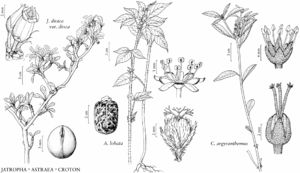Astraea
Arch. Naturgesch. (Berlin) 7: 194. 1841.
| Taxon | Illustrator ⠉ | |
|---|---|---|
 | Croton argyranthemus Astraea lobata Jatropha dioica var. dioica | Barbara Alongi Barbara Alongi Barbara Alongi |
Herbs [subshrubs, shrubs], annual [perennial], monoecious; hairs unbranched and stellate; latex colorless. Leaves alternate, simple [palmately compound]; stipules present, persistent; petiole present, glands present at apex; blade unlobed or palmately lobed, margins serrate [entire], laminar glands absent; venation palmate at base, pinnate distally. Inflorescences bisexual (pistillate flowers proximal, staminate distal), terminal, racemes [thyrses]; glands subtending each bract 0. Pedicels present. Staminate flowers: sepals 5, imbricate, distinct; petals 5, distinct, white [to pink]; nectary extrastaminal, 5 glands; stamens 8–15, inflexed in bud, distinct; pistillode absent. Pistillate flowers: sepals 5 (–7), usually not touching in bud, connate basally; petals 0; nectary 5 glands; pistil 3-carpellate; styles 3, connate basally [distinct], multifid. Fruits capsules. Seeds oblong-rectangular; caruncle present. x = 9.
Distribution
Introduced; Fla., Mexico, West Indies, Central America, South America, also in Asia (Arabian Peninsula), also in Asia (India), Africa, tropical and subtropical areas
Discussion
Species ca. 12 (1 in the flora).
Astraea was treated as a section of Croton by G. L. Webster (1993). However, the molecular phylogeny of P. E. Berry et al. (2005) showed that it represents a lineage distinct from Croton. Morphological characters that support this separation include the markedly rectangular seeds, the often deeply lobed leaves, and the mixture of simple and stellate hairs. Astraea is most diverse in southeastern Brazil.
Selected References
None.
Lower Taxa
"connate" is not a number. "distinct" is not a number.